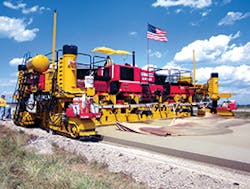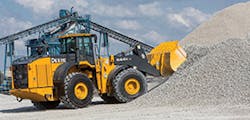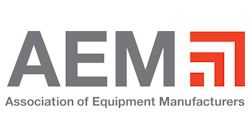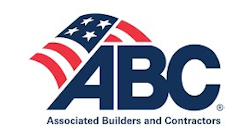The big show came alive with developments in wireless connectivity and machine-to-office data flow at CONEXPO-CON/AGG 2014, held in March in Las Vegas.
Numerous original equipment manufacturers (OEMs) and aftermarket suppliers like Trimble, Topcon, and Leica all demonstrated what their systems can do.
Trimble systems can connect the entire job site, wirelessly, to the office. Dozers, for example, have Trimble’s GCS900 grade control systems that feature automatic blade control. Plus, the Connected Machine feature now comes standard on all GCS900 systems, which brings the office and the machine together for increased efficiency. The Digital Terrain Model, a design model of the fully graded site, is sent to each machine, and each machine collects as-built data as it is working.
“It’s like a continuous loop of flowing data,” says Roz Buick, Trimble’s vice president and general manager of heavy/civil construction. “When the machine is working it communicates how much earth it has moved. We can send that through a wireless connection to the office. Machines receive signals of work orders.
Using VisionLink, Trimble’s office software, instructions are sent out to the machines onsite, and now users can track progress according to the plan. “We do it in real time,” says Buick. “And now we have LoadRite, which can weigh every bucketful from a wheel loader or excavator to help track earthwork quantities. The whole job site is connected wirelessly. We want the foreman to know how much earth he moved this week.”
We asked Buick what reports Trimble systems can provide. “We can do machine utilization, cycle counts, and reports on operator productivity,” says Buick. “If a hauler operator is speeding, we can tell that.”
Buick notes that the major OEMs, as represented by AEM, the Association of Equipment Manufacturers, and AEMP, the Association of Equipment Management Professionals, have agreed on a defined set of asset data that, when communicated remotely via telematics, can be sent to equipment end users. At CONEXPO, AEM and AEMP announced that 19 data points and 42 fault codes will be part of an expanded standard that was originally developed by AEMP and a handful of OEMs in 2008. Under a new AEM/AEMP partnership, the standard will now be regularly updated jointly by the two associations and its members. All construction companies will have to come to AEMP to get the standard document via a registration process.
This Gomaco paver is equipped with a 3D machine control system from Leica Geosystems.
Under the agreement, data will be provided to contractors via an Application Program Interface (API) server-to-server data sharing standard. “Basically the API takes data coming from the contractor’s fleet-which always includes machines from a variety of OEMs-and makes the language common,” says Stan Orr, AEMP president and chief strategy officer.
In the past, end users had to go to each manufacturer’s web site to get their telematics information, such as fuel usage, run times, locations, etc. “You almost had to cut and paste it into a spreadsheet,” says Orr. “That’s very time consuming, because everybody has a mixed fleet. The API creates it into a single language so that it will all feed into one page, basically.
“Each manufacturer, even for something as simple as fuel consumption, measures it differently,” says Orr. “The manufacturers have different codes for the telematics data. So what this does is to take those different ways of looking at fuel consumption, for one example, and homogenizes it so that it’s all the same to the end user. This API provides standardization and communication protocols for the transfer of that data to the end user’s business enterprise software.”
Orr says the agreement does not mean that the information from various OEMs’ equipment will be aggregated into one server, or one place in the cloud. “There’s concern by both the manufacturers and the fleet owners regarding the aggregation of data,” says Orr. “The manufacturers don’t want it aggregated because they don’t want somebody to come along and say this piece of equipment is better than that one based on this telematics data. And that makes sense. And the end users don’t want their data out there floating around that could fall into the hands of their competition. So there’s this whole protection of the data issue.”
The API allows telematics data-which belongs to the end user-to come from the manufacturer in a common format and be fed to a computer on the fleet manager’s desk. “In the simplest terms, the equipment manager can look at all of his data on one screen, instead of having to look at it from multiple screens,” says Orr. “It’s going to feed into enterprise software, like a J.D. Edwards or something like that.”
At CONEXPO, Caterpillar exhibited Cat Connect, which is an umbrella term covering a combination of technologies and dealer services that the company markets. “We provide value in four areas,” says John Thomas, Cat’s construction technology marketing and strategy manager. “The four are equipment management, productivity, safety and sustainability. And we have six types of technologies that we apply to help customers capture that value.” Among the six technologies:
- Product Link– Caterpillar’s telematics system. One can now add grading information and production data to the list of machine performance and maintenance data points included in Product Link.
- Grade control technology– For several years, Cat has offered Accugrade machine control systems, which provide automatic blade control technology.
- Compact– This is similar to Grade Control, but applies to soil and asphalt compaction. It includes intelligent compaction information, pass count mapping, and the like.
- Payload– This is a scale system to weigh material by the bucket or by the hauler load. “We have it on our large wheel loaders and on articulated and rigid frame trucks,” says Thomas. “And we’re releasing it this year on excavators and on wheel tractor scrapers.” This will enable end users to track production information in real time.
Thomas says Product Link can transfer information about all four technologies to a central server. The data can then be viewed in one place by customers through VisionLink software.
The other two technologies are Detect, which is a combination of rear vision cameras and radars, to detect obstacles-and Remote Control of Machines. Remote control comes only on large Cat dozers, and it’s driven by the need for safety in special situations, such as where an operator might go over a vertical incline, or in cases of toxic materials.
Contractors probably don’t need all of those products and services at once, Thomas says. Each component can be acquired individually. Machine information first flows to a Caterpillar server, but the customer owns the data. “If they don’t want to use VisionLink, they can get a data feed that pulls raw data out of our servers,” says Thomas. “It pulls information into Enterprise Planning Software-like SAP, for example.”
Customers can get standard reports from their machines, such as idle times, fuel usage, and working times. If a contractor transfers the data to VisionLink, he can get reports on the production of each machine, or of the entire fleet. “And, yes, the software can work with mixed fleets-it doesn’t all have to be Caterpillar equipment. “Trimble enables us to serve different manufacturers,” says Thomas. “Our partnership with Trimble enables us to get information about grade, compact, and payload to VisionLink for mixed fleet customers.”
From Topcon comes Sitelink 3D, with which every machine on a job site has Topcon’s grade control system or an HT-30 haul truck module. Topcon introduced the HT-30 at CONEXPO, and it features a small, portable GPS-enabled control box that mounts into the truck cab. As the truck is loaded, data about the load is entered, such as material type, driver, and quantity. The load is then integrated into Sitelink3D and can be tracked for scheduling, rerouted if needed elsewhere, and recorded once delivery is made.
With Sitelink 3D, a remote manager can connect to a grade-control enabled machine and control the operator’s GPS system. “You can load surfaces from a remote location, change offsets, and generally support the machine,” says Mike Wehling, Enterprise 3D specialist with Topcon. “I use it for training. I could get an operator up and running in 10 minutes versus sending somebody out there to teach him the system. We can send design files to the machine.
“This system is especially useful for big design/build projects, where construction starts before design is complete,” says Wehling. “With those projects you get a lot of changes, and you can keep the machines updated. I can send data to one machine, or to several machines, or to the cloud. When an operator turns on the machine, he gets the data from the server.
“Then we add Enterprise, which adds productivity to the mix,” says Wehling. “If you take pile A and move it to hole B, it will define that you’re using an excavator, where you do it, when you do it, and how fast you do it. It can define the task type, the scheduled start, and the scheduled volume of production. If my estimate says I will carry 15 yards per load, and do six loads a day, then I know I’m making money if I beat the estimate.”
Leica Geosystems exhibited its iCON telematics system at CONEXPO. It permits remote access to GPS-equipped machines on the job site. “We can see what the machine operator is seeing in real time,” says Magnus Thibblin, segment manager, NAFTA Machine Control, Leica Geosystems. “You don’t have to wait to get help. A remote manager can give the operator support, trouble-shooting, or training-all from a desktop computer.
“We’re developing a production control solution to connect all of the machines on a job site,” says Erik Trehn, Leica’s product manager for telematics and production control. “The 3D design files for a project are all available on an Internet interface in each machine on a multimachine job site. You sit in an office, and you can put a design file on the central server and each machine can get access to that file-that’s our Sync feature.
“We also have the View feature,” Trehn continues. “From a remote location you can take control of the machine control system. You can see what the operator sees on the job. And we have the Track feature. Machines send in their positions to the central server, and we can display locations of all machines on one map.
Standard features of John Deere’s Ultimate
Uptime include JDLink Ultimate telematics,
which is Deere’s proprietary machine
monitoring system.
Plus, the Leica system permits a user to upload a design map and overlay it on a Google map of the existing topography. “We can also generate reports that show machine speed, locations, maintenance schedules,” says Trehn. “In the future we will be able to measure cubic yards per shift.”
Later this year, Leica plans to offer a production application for an iPad mounted in a truck. An operator will record the position, time and type of load; he presses the load button, and then when he dumps, he presses the dump button. “It uses a standard volume for the dump truck,” says Trehn. Later this year, a Leica Earthmover module will permit production information to flow to the cloud, where a central server can access it. Then, production reports will be possible.
In April of last year, Case Construction Equipment announced the launch of Case SiteWatch, its telematics, remote monitoring and data reporting solution that provides customers with information to help manage their fleets and optimize machine performance. Using a control module that integrates with the machine, SiteWatch sends real-time data to a user Web portal accessible from nearly anywhere in the world. An intuitive interface allows customers and dealers to review and analyze up to 18 months’ worth of information.
At CONEXPO, Case said the company plans to make a transition from its current telematics system to one that can record production information, but that is not possible now. “I can’t share much about it, but yes, we plan to integrate it into bucket weigh systems and things like that,” said Brad Stemper, solutions marketing manager, Case Construction Equipment.
Stemper said Case plans to be able to enter a design file into a computer on an earthmoving machine. Currently Case does not offer a factory-integrated blade control system. Instead, Case offers a partnership with all three aftermarket vendors: Trimble, Topcon, and Leica. Case machines are set up at the factory to receive a machine control system from any of those three vendors.
John Deere announced Ultimate Uptime at CONEXPO. Standard features of Ultimate Uptime include JDLink Ultimate telematics, which is Deere’s proprietary machine monitoring system. It provides remote access to fleet location, machine health alerts, and preventive maintenance tracking. Deere says it has two industry exclusives. One is machine health prognostics. With that, JDLink, fluid analysis, and machine inspection data is processed through analytic software. It’s basically a system of predictive maintenance.
The second Deere exclusive is remote diagnostics and programming. A John Deere dealer can read and reset diagnostic codes, record machine performance data, and even update software without a trip to the job site. When a visit is required, the technician can often arrive with the right parts already in hand.
Summing up, it’s an exciting time for new equipment. The manufacturers are announcing Final Tier 4 engines, and they’re ready to move beyond emissions control technology. Certainly, the connected worksite and real-time production information will play an important role in the days and years ahead.











